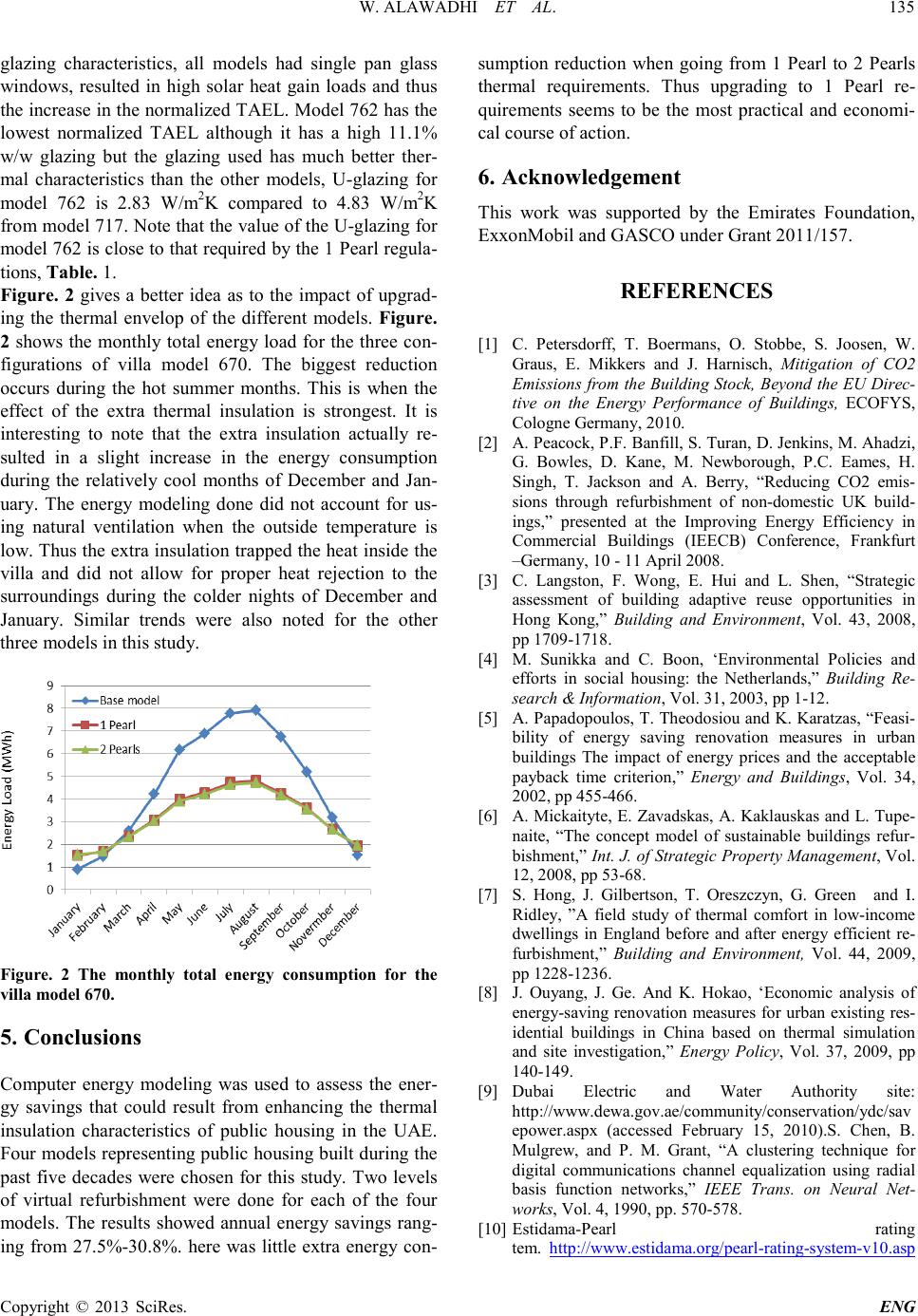
W. ALAWADHI ET AL.
Copyright © 2013 SciRes. ENG
glazing characteristics, all models had single pan glass
windows, resulted in high solar heat gain loads and thus
the increase in the normalized TAEL. Model 762 has the
lowest normalized TAEL although it has a high 11.1%
w/w glazing but the glazing used has much better ther-
mal characteristics than the other models, U-glazing for
model 762 is 2.83 W/m2K compared to 4.83 W/m2K
from model 717. Note that the val ue o f t he U-glazing for
model 762 is close to that required by the 1 Pearl regula-
tions, Table. 1.
Figure. 2 gives a better idea as to the impact of upgrad-
ing the thermal envelop of the different models. Figure.
2 shows the monthly total energy load for the three con-
figurations of villa model 670. The biggest reduction
occurs during the hot summer months. This is when the
effect of the extra thermal insulation is strongest. It is
interesting to note that the extra insulation actually re-
sulted in a slight increase in the energy consumption
during the relatively cool months of December and Jan-
uary. The energy modeling done did not account for us-
ing natural ventilation when the outside temperature is
low. T hus the extra insul atio n tra pped the heat insi de the
villa and did not allow for proper heat rejection to the
surroundings during the colder nights of December and
January. Similar trends were also noted for the other
three models i n th is study.
Figure. 2 The monthly total energy consumption for the
villa model 670.
5. Conclusions
Computer energy modeling was used to assess the ener-
gy savings that could result from enhancing the thermal
insulation characteristics of public housing in the UAE.
Four models repr esenti ng publ ic housi ng buil t duri ng the
past five decades were chosen for this study. Two levels
of virtual refurbishment were done for each of the four
models. T he results sho wed annual energy savings rang-
ing from 27.5%-30.8%. here was little extra energy con-
sumption reduction when going from 1 Pearl to 2 Pearls
thermal requirements. Thus upgrading to 1 Pearl re-
quirements seems to be the most practical and economi-
cal course of action.
6. Acknowledgemen t
This work was supported by the Emirates Foundation,
ExxonMobil and GASCO under Grant 2011/157.
REFERENCES
[1] C. Petersdorff, T. Boermans, O. Stobbe, S. Joosen, W.
Graus, E. Mikkers and J. Harnisch, Mitigation of CO2
Emissions from the Building Stock, Beyond the EU Direc-
tive on the Energy Performance of Buildings, ECOFYS,
Cologne Germany, 2010.
[2] A. P eacock, P. F. Banfill , S. Turan, D. Jen kins, M. Ahadzi ,
G. Bowles, D. Kane, M. Newborough, P.C. Eames, H.
Singh, T. Jackson and A. Berry, “Reducing CO2 emis-
sions through refurbishment of non-domestic UK build-
ings,” presented at the Improving Energy Efficiency in
Commercial Buildings (IEECB) Conference, Frankfurt
–German y, 1 0 - 11 April 2008.
[3] C. Langston, F. Wong, E. Hui and L. Shen, “Strategic
assessment of building adaptive reuse opportunities in
Hong Kong,” Building and Environment, Vol. 43, 2008,
pp 1709-1718.
[4] M. Sunikka and C. Boon, ‘Environmental Policies and
efforts in social housing: the Netherlands,” Building Re-
search & Information, Vol. 31, 2003, pp 1-12.
[5] A. Papadopoulos, T. Theodosiou and K. Karatzas, “F easi-
bility of energy saving renovation measures in urban
buildings The impact of energy prices and the acceptable
payback time criterion,” Energy and Buildings, Vol. 34,
2002, pp 455-466.
[6] A. Mickaityte, E. Zavadskas, A. Kaklauskas and L. Tupe-
naite, “The concept model of sustainable buildings refur-
bishment,” Int. J. of Strategic Property Management, Vol.
12, 2008, pp 53-68.
[7] S. Hong, J. Gilbertson, T. Oreszczyn, G. Green and I.
Ridley, ”A field study of thermal comfort in low-income
dwellings in England before and after energy efficient re-
furbishment,” Building and Environment, Vol. 44, 2009,
pp 1228-1236.
[8] J. Ouyang, J. Ge. And K. Hokao, ‘Economic analysis of
energy-saving renovation measures for urban existing res-
idential buildings in China based on thermal simulation
and site investigation,” Energy Policy, Vol. 37, 2009, pp
140-149.
[9] Dubai Electric and Water Authority site:
http://www.dewa.gov.ae/co mmunity/conservation/ydc/sav
epower.aspx (accessed February 15, 2010).S. Chen, B.
Mulgrew, and P. M. Grant, “A clustering technique for
digital communications channel equalization using radial
basis function networks,” IEEE Trans. on Neural Net-
works, Vol. 4, 1990, pp. 570-578.
[10] Estidama-Pearl rating
tem. http ://www.estidama.org/pearl-rating-syst em-v10.asp